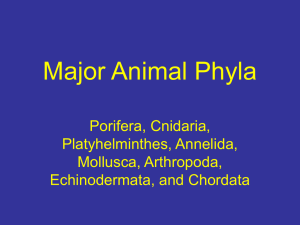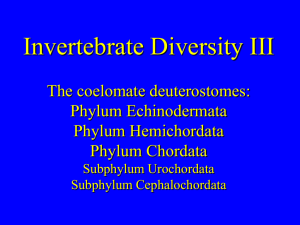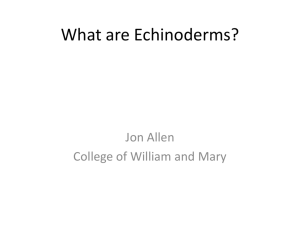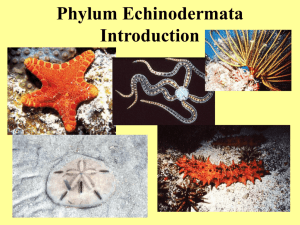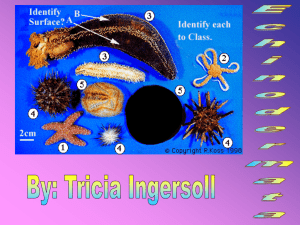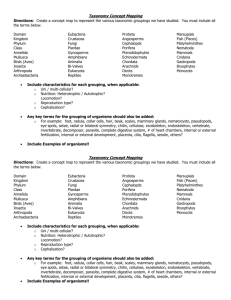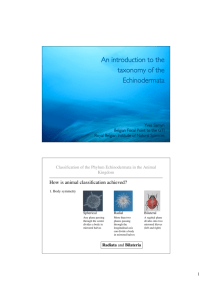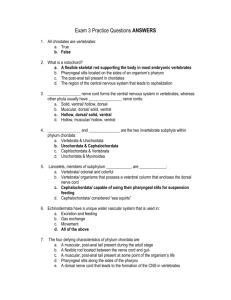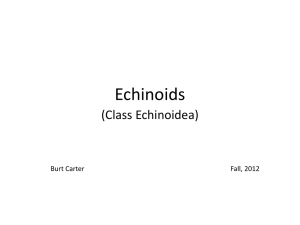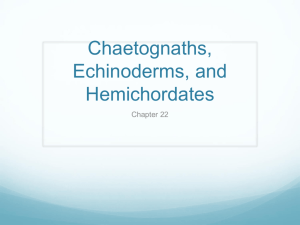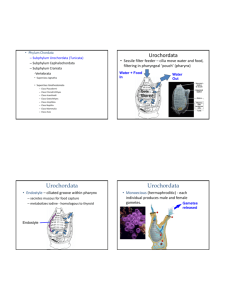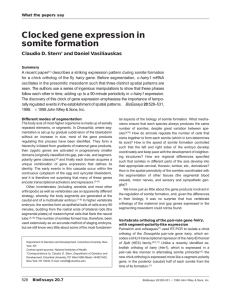Biology II Lab Practical Review Part II
advertisement
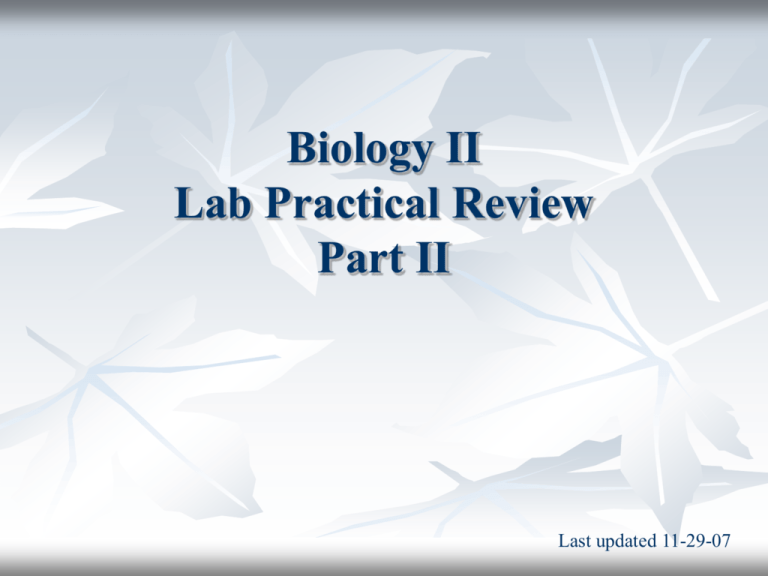
Biology II Lab Practical Review Part II Last updated 11-29-07 Fungi Phyla Chytridiomycota Zygomycota Glomeromycota Ascomycota Basidiomycota Basidiomycota Aspergillis Ascomycota - mold Ascomycota http://www2.muw.edu/~mharvill/index.html Ascomycota Zygomycota - Rhizopus Name the phylum and explain the pictures. http://www.ffp.csiro.au/research/mycorrhiza/vam.html Answer: Glomeromycota. They are endomycorrhizae. The tips of the hyphae push into plant root cells and branch into tiny treelike structures known as arbuscles. Fungi Reproduction Basidia Zygoyte Rhizopus Ascospores Inside Ascus Conidia - Asexual Ascomycota Yeast budding Lichen Lichen are a symbiotic association composed of: a. mycorrhizae and green algae b. nodules and cyanobacteria c. fungi, cyanobacteria and/or green algae d. chlorophyta and green algae e. a. and b. Answer: c. Fruticose Foliose Crustose Crustose Fruticose Embryology What is the difference between phylogeny and ontology? Answer: One is the study of evolutionary relationships among organisms and the other is the development of an individual organism from egg to adult. Cell Division Mesenchyme Archenteron Morula Gastrula Blastocoel Blastula midbrain Locate on diagram: forebrain somite eye midbrain pharynx heart neural tube somite ear hindbrain hindbrain ear pharynx eye forebrain heart somite neural tube somite 48 hr. chick – dorsal view Chorion Embryo Amnion Allantois Yolk sac Yolk Extraembryonic Membranes What are the functions of the extraembryonic membranes? Answer: Amnion - protects the embryo Chorion - gas exchange Allantois - waste disposal & gas exchange Yoke sac - surrounds yoke for nutrients Germ Layers What are the three germ layers? Answer: Ectoderm, Endoderm, Mesoderm What body tissues are derived from each? Answer: Ectoderm - epidermis of skin, mouth & rectum lining, eye, nervous system, tooth enamel Endoderm – lining of digestive tract and respiratory system, liver, pancreas, thyroid, lining of reproductive system Mesoderm – notocord, skeleton, muscles, circulatory system, reproductive system, excretory system, skin dermis, body cavity lining Invertebrates Porifera What are the body plans below? Answer: ascon, sycon, leucon Cnidaria Anthozoa Scyphozoa Hydrozoa Ctenophora Comb Jelly Cubozoa Platyhelmenthes Turbellaria Turbellaria Cestoda Trematoda Monogenea Nemertea Rotifera Nematoda Male or female? Answer: Male Arthropoda Crustacea and Insecta are distinct from each other in that a. Crustacea have segmented legs b. Insects have segmented legs c. Crustacea have two pairs of antenna d. Insects have two pairs of antenna e. a. & b. Answer: c Arthropoda Classes Myriapoda Subclass Diplopoda Myriapoda Subclass Chilopoda Arachnida Crustacea Insecta Match the letter to the number 1. 2. 3. 4. 5. 6. 7. 8. 9. Porifera Cnidaria Ctenophora Platyhelmenthes Mollusca Nematoda Annelida Arthropoda Echinodermata a. b. c. d. e. f. g. h. i. Diplopoda Roundworm Cephalopoda Turbelaria Hydrozoa Comb jelly Ophiuroidea Oligochaeta Ascon body type Answers: 1(i), 2(e), 3(f), 4(d), 5(c), 6(b), 7(h), 8(a), 9(g) a. d. Echinodermata a. Asteroidea b. Holothuroidea c. Crinoidea d. Ophiurodea e. Echinoidea b. e. f. Echinoidea g. Concentricycloidea c. g. f. a. d. Echinodermata a. Asteroidea b. Holothuroidea c. Crinoidea d. Ophiurodea b. e. Echinoidea e. f. Echinoidea c. f. Mollusca Polyplacophora Cephalopoda Gastropoda Cehpalopoda Bivalvia Cephalopoda Annelida Oligochaeta Hirudinia Polychaeta Match the letter with the number. Answers may be used more than once. 1. Platyhelmenthes 2. Roundworms 3. Earthworm 4. Mouth first 5. Anus first 6. lack tissue 7. true tissue a. parazoa b. acoelomate c. pseudocoleomate d. deuterostome e. protostome f. eumetazoa g. coelomate Answer: 1b, 2c, 3g, 4e, 5d, 6a, 7f Vertebrates What are the four main characteristics of Chordata? Answer: Notocord. Flexible, rod-like. Replaced by vertebrae of backbone in vertebrates. Pharyngeal gill slits from throat to exterior Dorsal hollow nerve cord whose main cord is solid Post-anal tail The subphyla of Chordata are? a. Urochordata, Asteroidea, Cephalochordata b. Vertebrata, Cephalochordata, Agnatha c. Cephalochordata, Agnatha, Actinistia d. Urochordata, Cephalochordata, Vertebrata e. None of the above Answer: d Which subphylum do Tunicates belong? Answer: Urochordata Match the letter with the number.Answer only used once. 1. 2. 3. 4. Shark Perch Frog Pig Answer: 1c, 2a, 3d, 4b a. Class Actinopterygii b. Class Mammalia c. Class Chondrichthyes d. Order Anura Reptilia Order Crocodilia Order Squamata Order Chelonia Order Sphenodontia Order Squamata Orders of Placental Mammals Sirenia Rodentia Proboscidea Lagomorpha Insectavora Primates Perissodactyla Perissodactyla Artiodactyla Artiodactyla Chiroptera Cetacea Mammals Order Monotremata Order Marsupials Class Aves Carinates Ratites Frog Heart Liver c. b. d. Small intestines a. Fat bodies e. Stomach c. male or female? female b. heart a. cloaca Shark Pig a. heart lung c. b. liver b. swim bladder gills a. e. ovary c. liver d. stomach f. intestine
